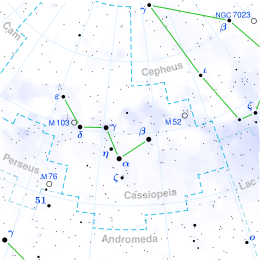YZ Cassiopeiae (21 Cas) is a star system 103.8 parsecs (339 ly) away from Earth, in the constellation Cassiopeia. It comprises three stars: an eclipsing Algol-type binary and a visually fainter star about 3000 AU distant.[10]

The primary star in the YZ Cassiopeiae system is a white subgiant (main sequence) star of spectral type A1Vm and 2.31 solar masses[10] (M☉) with a less massive main sequence dwarf star of type F2V[2] and 1.35 M☉.[10] The apparent magnitude of the eclipsing binary varies from 5.65 to 6.05[2] with a period of 4.4672 days.[10] Combined, they appear to have a spectral type of A2IV.[10]
The binary has a dimmer (magnitude 9.7 according to Norton,[15] or 10.5 by SIMBAD) companion of 0.8 M☉[10] orbiting with a period of about 86 580 years.[10]
- ^ a b c d e Cite error: The named reference
hipparcoswas invoked but never defined (see the help page). - ^ a b c Jerzy M. Kreiner, Chun-Hwey Kim, Il-Seong Nha. YZ CAS: Atlas of O-C Diagrams of Eclipsing Binary Stars
- ^ a b Cite error: The named reference
tychowas invoked but never defined (see the help page). - ^ a b c d e Cite error: The named reference
eggenwas invoked but never defined (see the help page). - ^ Cite error: The named reference
grenierwas invoked but never defined (see the help page). - ^ a b Cite error: The named reference
bilirwas invoked but never defined (see the help page). - ^ Cite error: The named reference
gcvswas invoked but never defined (see the help page). - ^ a b c d e f g h Cite error: The named reference
pavlovskiwas invoked but never defined (see the help page). - ^ Cite error: The named reference
pulkovowas invoked but never defined (see the help page). - ^ a b c d e f g h Cite error: The named reference
Tokwas invoked but never defined (see the help page). - ^ a b c d e f g Cite error: The named reference
ekerwas invoked but never defined (see the help page). - ^ a b c Cite error: The named reference
maxtedwas invoked but never defined (see the help page). - ^ "V* YZ Cas". SIMBAD. Centre de données astronomiques de Strasbourg. Retrieved 26 January 2018.
- ^ Cite error: The named reference
MASTwas invoked but never defined (see the help page). - ^ Cite error: The named reference
Norwas invoked but never defined (see the help page).
